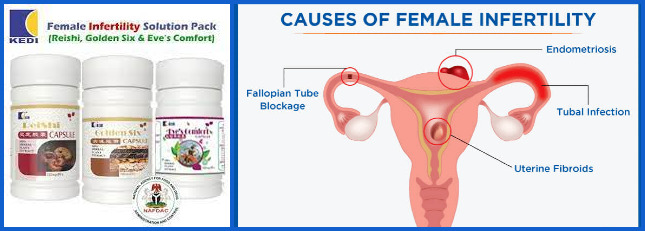CAUSES, SYMPTOMS FOR FEMALE INFERTILITY & USING KEDI PRODUCTS FOR TREATMENT
Infertile women are unable to conceive after at least a year of trying or after six months if they are over 35. Another term for infertility is repeated miscarriage. The following causes can contribute to female infertility:
- Hormonal problems
- Physical problems
- Age
- Lifestyle/Environmental factor.
SIGNS OF INFERTILITY IN WOMEN
- Hormone changes
- Irregular menstrual cycle.
- Dark or pale menstrual cycle
- Pain during sex
- Heavy, long, or painful periods
- Underlying medical conditions
- Obesity
- And not getting pregnant.

FEMALE INFERTILITY CAUSES AND KEDI HEALTHCARE THERAPY FOR EACH:
The most common causes include:
1. Failure to ovulate:
Ovulation failure, which affects 40% of women with infertility problems, is the most frequent general cause of female infertility. Numerous factors can prevent ovulation, including:
- Gynecological or ovarian disorders, such as polycystic ovary syndrome (PCOS) or primary ovarian insufficiency (POI) (PCOS).
- Aging, which includes a reduced ovarian reserve. This describes a woman's ovaries having fewer eggs than typical as she ages.
- Endocrine abnormalities, such as thyroid illness or issues with the hypothalamus, have an impact on how much or how little of a certain hormone or collection of hormones the body produces.
KEDI Herbal Treatment:
2. Endometriosis: when uterine lining tissue is discovered in locations other than the uterus, such as obstructing the fallopian tubes. Treatment stage:-
3. Uterine fibroids:
growths that develop within and around the uterine wall, however, the majority of women with fibroids are fertile and able to become pregnant. However, some women with fibroids may find it difficult to conceive naturally, experience multiple miscarriages, or give birth prematurely. Treatment stage:-
4. INFECTIONS:
Women with untreated venereal diseases like staphylococcus aureus, gonorrhea, and chlamydia may develop pelvic inflammatory disease, which may result in fallopian tube obstruction due to scarring. A sexually transmitted disease that is left untreated makes a pregnant woman more likely to experience a stillbirth.
Cervical chronic infection and surgical removal of lesions brought on by human papillomavirus (HPV) infection can also lessen the quantity or quality of cervical mucus.
It may be challenging for women to become pregnant if there are issues with this clingy or slippery substance that builds up on the cervix and in the vagina. Treatment stage:
5. Polyps:
These are benign tumors that develop on the uterus' inside surface. It may be challenging for a woman to maintain pregnancy after conception if she has polyps since they can interfere with the uterus' normal function. Treatment stage:-
6 . Scarring:
from previous wounds, infections, or surgery in the uterus. Scarring may prevent implantation and raise the chance of miscarriage, both of which may lead to infertility. Treatment stage:-
In Conclusion:
The products listed above have produced outstanding results for promoting fertility or increasing a woman's chances of pregnancy. Following the detoxification phase, the therapy phase should last between 30 and 90 days, depending on the underlying cause of infertility and the availability of healthy, high-quality sperm.
